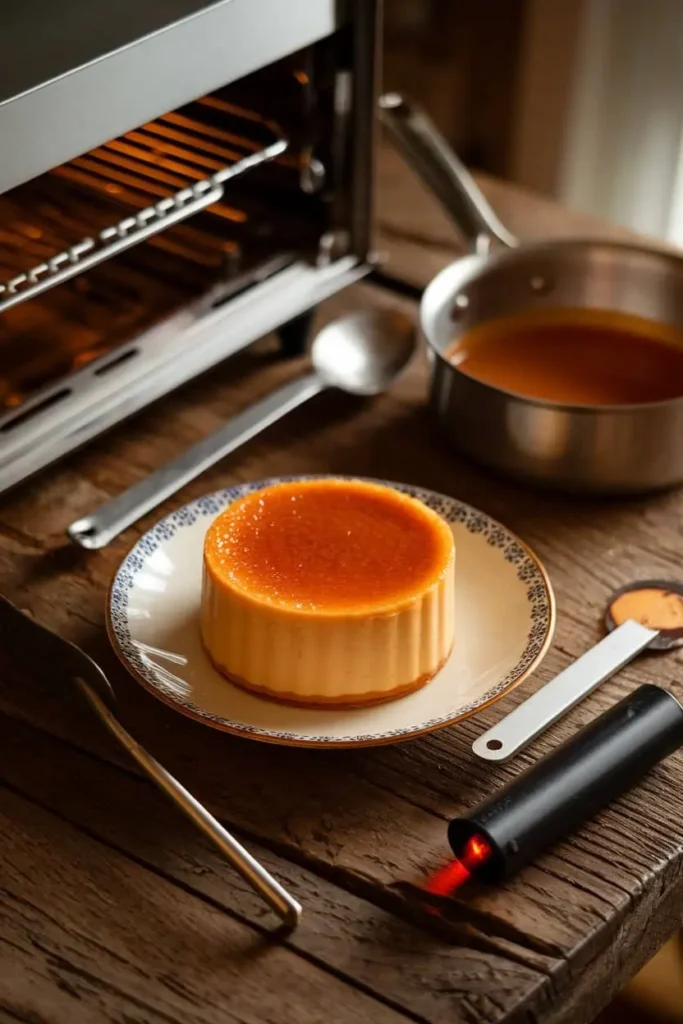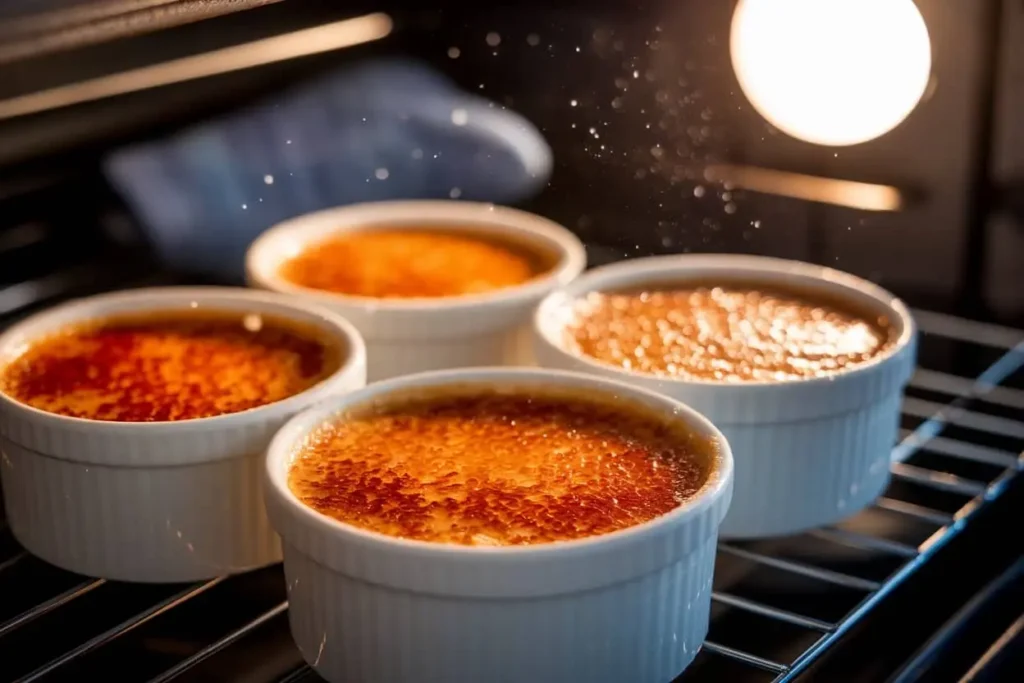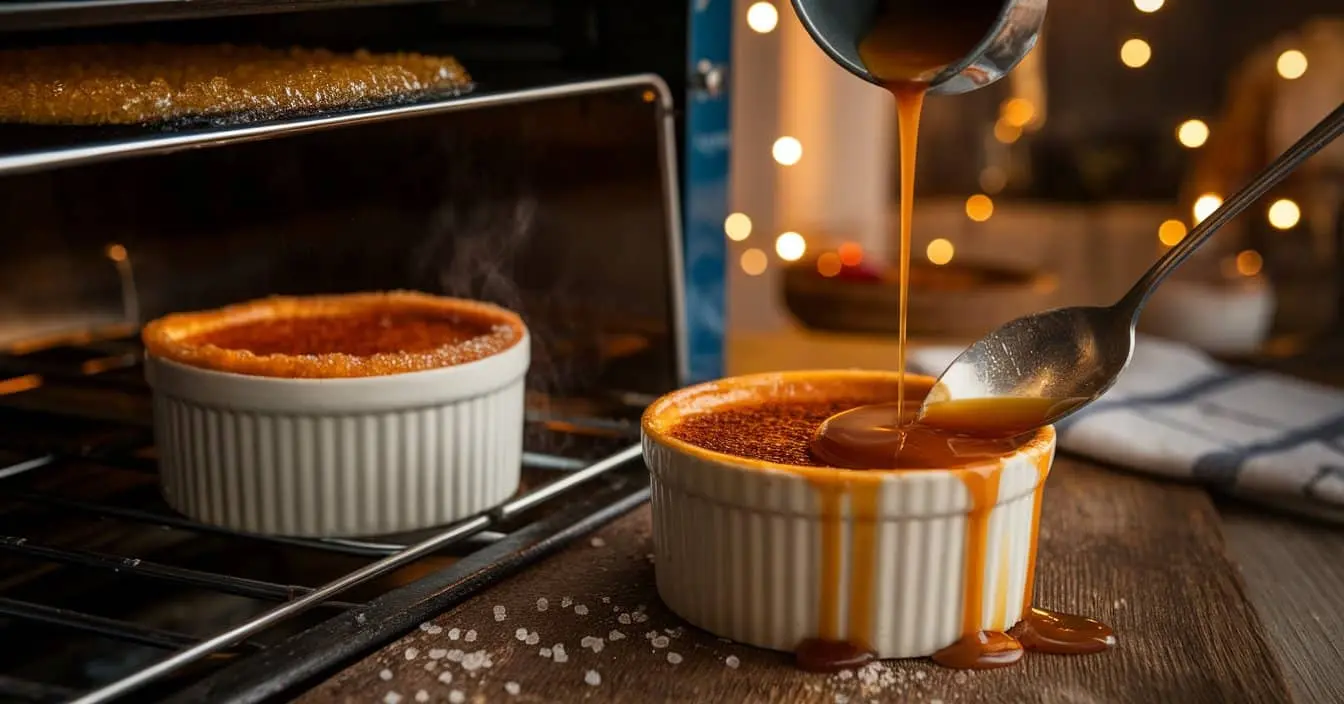Crème brûlée is a classic French dessert, famous for its silky custard base and crisp caramelized sugar topping. Traditionally, a culinary torch is used to achieve that signature glassy crunch, but what if you need to make crème brûlée without a torch? No worries! There are several easy ways to caramelize sugar using common kitchen tools.
In this guide, we’ll explore alternative methods for caramelizing sugar, why caramelization is essential, and expert tips for the best results—all without needing a torch.
For more on achieving the perfect texture and taste, check out what is the secret of crème brûlée.

Why Caramelization Matters in Crème Brûlée
Caramelization is key to the flavor and texture of crème brûlée. The process:
- Melts sugar to form a crispy, golden-brown topping.
- Creates a contrast between the hard sugar crust and the smooth custard beneath.
- Enhances the overall taste with a slightly burnt, caramelized flavor.
The sugar caramelizes at 320°F to 350°F (160°C to 180°C), requiring high, direct heat. While a torch provides precision, there are alternative methods that can work just as well.
If you’re curious about the differences between crème brûlée and other custards, read the difference between crème brûlée and custard.
How to Caramelize Sugar Without a Torch
1. Broiler Method (Oven Caramelization)
One of the easiest methods is using your oven’s broiler setting. This method mimics the high heat of a torch.
How to Do It:
- Preheat your oven’s broiler to the highest setting.
- Sprinkle an even layer of white sugar over the crème brûlée.
- Place the ramekins on the top oven rack—as close to the heat source as possible.
- Broil for 1-3 minutes, watching carefully to prevent burning.
Pros:
✔ Easy—most ovens have a broiler.
✔ Creates an even, crispy caramel layer.
Cons:
✘ Can overheat the custard.
✘ Less control over caramelization.
For more details, check out this guide on how to caramelize sugar under a broiler.
2. Caramel Pour Method (Stovetop Caramelization)
This method involves making a liquid caramel on the stovetop and pouring it over the custard.
How to Do It:
- In a saucepan, melt ¼ cup of sugar over medium heat until golden brown.
- Immediately pour the hot caramel thinly over the chilled custard.
- Let it harden for about 5 minutes before serving.
Pros:
✔ Produces an authentic hard sugar crust.
✔ Doesn’t require an oven or special tools.
Cons:
✘ Requires careful timing—caramel hardens fast.
✘ Can result in an uneven sugar layer.
3. Heated Spoon Method
If you have a metal spoon and a stove, you can create a caramelized crust without any special tools.
How to Do It:
- Heat a metal spoon directly over a gas stove flame or electric coil.
- Sprinkle sugar evenly over the custard.
- Press the hot spoon onto the sugar to caramelize it.
Pros:
✔ No special equipment is required.
✔ Provides a decent caramelization effect.
Cons:
✘ Takes longer and may be uneven.
✘ Can be tricky to heat the spoon evenly.
4. Candle or Grill Lighter Method
A long-reach lighter (like those used for candles or grills) can also caramelize sugar.
How to Do It:
- Sprinkle sugar evenly over the custard.
- Hold the lighter’s flame just above the sugar, moving it in circles.
Pros:
✔ Cheap and accessible.
✔ Easy to control.
Cons:
✘ Takes more time than a torch.
✘ Doesn’t provide even caramelization.
Tips for Best Results
✅ Use superfine sugar—it caramelizes more evenly than coarse sugar.
✅ Chill your custard well before caramelizing to prevent overheating.
✅ Work quickly if using the caramel pour method to avoid solidification.
For a unique twist on this classic dessert, try a savory variation like crab brûlée, which puts an innovative spin on the traditional dish.

FAQs: Common Questions About Crème Brûlée Without a Torch
Can I use a hairdryer to caramelize crème brûlée?
No, a hairdryer does not produce enough heat to caramelize sugar properly.
What’s the best type of sugar to use?
White granulated sugar works best because it melts evenly and forms a crisp crust.
Is using a broiler safe for crème brûlée?
Yes, but be careful not to overheat the custard. Keep a close watch while broiling.
Can I use brown sugar instead of white sugar?
Yes, but brown sugar melts differently and may not create the same glassy caramel crust.
Conclusion
Even if you don’t have a crème brûlée torch, you can still create a delicious, caramelized topping using the methods above. Whether you opt for the broiler, caramel pour, heated spoon, or lighter method, each has its benefits.
Try different techniques and find the one that works best for you. Happy baking!
